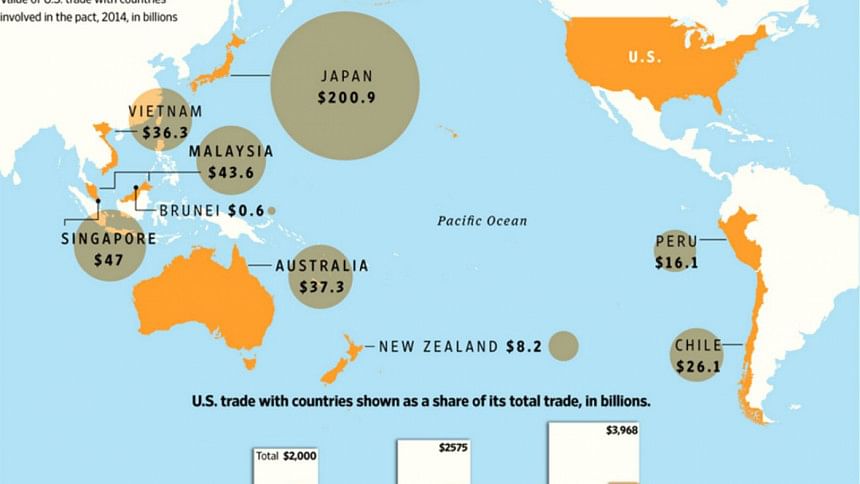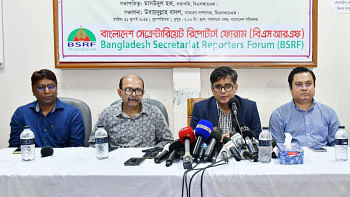Trans-Pacific Partnership Treaty and Bangladesh

The Trans-Pacific Partnership (TPP) treaty currently under negotiation could potentially affect Bangladesh's economy in the near future, although at this point it is not clear how large the impact might be since many of the details are still under wrap. However, it is known that some of Bangladesh's major trading partners, including the USA and Japan, have joined the Partnership, and so is Vietnam which is a significant competitor in the international readymade garments market. Therefore, in the coming months it behooves well for Bangladesh to pay close attention to the final outcome of the treaty and undertake effective measures to counter any adverse effect on our economy.
TPP has been in the works for over five years. Currently twelve countries accounting for 40 percent of the world's GDP are slated to be signatories to this agreement: Australia, Brunei Darussalam, Canada, Chile, Japan, Malaysia, Mexico, New Zealand, Peru, Singapore, the US, and Vietnam.The treaty has both trade and non-trade sections. The main feature of this treaty envisages that tariff and non-tariff barriers to trade between the signatories will be eliminated and members will refrain from currency manipulation. There are other aspects particularly as they relate to intellectual property and investment. The Obama Administration is strongly pushing the agreement with Congress and the public. According to the US Trade Representative's office, it is "a trade agreement that will open markets, set high-standard trade rules, and address 21st-century issues in the global economy. By doing so, TPP will promote jobs and growth in the United States and across the Asia-Pacific region." However, as can be expected with a treaty of such global reach, until "all t's are crossed and i's dotted", many aspects will remain under a cloud of uncertainty.
The effect of any free trade agreement depends on the countries involved, the scope of the treaty, the time frame, and the commodities covered. When two countries decide to lower tariffs on their imports from each other, they import more from the partner. This is due to two effects: trade creation and trade diversion. For example, if United State lowers tariff on Vietnam's steel, the US will import cheaper steel from Vietnam at the expense of domestic steel mills. This is an instance of trade creation. On the other hand, if increased import of steel from Vietnam reduces US steel imports from China, increased trade between USA and Vietnam happens at the expense of China, and US trade with China is reduced i.e., diverted. In the previous scenario, if you switch the countries, Bangladesh for China, and also readymade garments for steel, you can probably get a sense of the potential impact of TPP on Bangladesh in the not too distant future.
At the recently concluded Bangladesh Development Conference at Harvard University, many international observers voiced their concern that due to tariff preferences and technology transfers following TPP, Vietnam is likely to overtake Bangladesh as the second largest RMG exporter in global trade by 2024. A researcher observed that if TPP adopts the flexible rule of origin on sourcing, as favoured by Vietnam, it could boost its share of the growing market from 4 percent to 11 percent, while Bangladesh's share remains almost stagnant in the 7-8 percent range. Currently, Vietnam is at a comparative disadvantage in the RMG world mainly due to its higher cost of production and greater labour cost. Bangladesh has been able to retain its edge in the sourcing world in spite of the higher tariff (Vietnam pays 8.38 percent in contrast to 15.61 percent for Bangladesh), but it is expected that TPP, once it is fully implemented, will trigger some trade diversion from Bangladesh to Vietnam.
An aspect of the treaty that might play an important role in the aftermath and its impacts on trade is the implementation of "Rules of Origin (ROO)" requirements. ROO define those goods that originate in the TPP countries and therefore are eligible for preferential treatment under the agreement. With regard to textiles and apparel, the United States has used the "yarn forward" rule in the past. This rule, stricter than the others, requires that an apparel product could be considered from within the free trade area, and therefore eligible for preferential treament, if the entire manufacture of the prouct, from the spinning of the yarn to final assembly, has occurred within the country or countries in TPP.
Representatives of the U.S. textile industry have argued for tighter "yarn forward rule" to be included in the TPP. Some U.S. apparel firms, retailers, and distributors, as well as some TPP countries, including Vietnam, seek a less restrictive "cut and sew," or single tranformation, rule, which would allow its products manufactured from materials of non-TPP origin to benefit from the TPP. Many alterntive variations or hybrid rules are also being considered. These are based on percentages of inputs, origin of inputs, and other criteria. However, it is known that flexible rules are opposed by some US partners, particularly Mexico and Peru, where textile and apparel industries have been oriented to trade with the United States. In the coming months, Bangladesh will need to keep an eye on the final outcome of the ROO negotiations since a) flexible rules will affect Bangladesh in the short run, while b) strict rules might give us headaches in the long run.
Another area where international investors might be giving Vietnam a slight head start is in the upstream industries. According to the Vietnam Investment Review, "a new wave of foreign investments in the spinning, weaving, and dyeing sectors has been kicked off, since investors can see the profits they can gain from the TPP." Trade journals report that foreign manufacturers have invested more than $1 billion in Vietnam's textile and apparel sector in anticipation of a TPP agreement. According to Saigon Times, textile and garment manufacturers based in Japan, Hong Kong, South Korea, Taiwan, Austria, and Australia are also setting up new production or have expanded current production in Vietnam.
Bangladesh trade officials, BGMEA and BKMEA, regulators, and the civil society need to also pay special attention to the TPP and other free-trade negotiations which are moulding "21st-Century Trade Policies". These new state-of-the-art trade deals offer prominence to environmental and labour standards, and might allow non-tariff barriers, such as burdensome safety standards or regulatory hurdles for trade services and direct foreign investment, to be codified. These, nonetheless, may no longer be overlooked in trade negotiations.
For Bangladesh, if the Treaty goes through, there are a number of pathways to mitigate the aftershocks, and take advantage of the opportunities. The most important impertive is for the government and the business community to keep it to the radar screen. In the worst-case scenario, Bangladesh might find itself in a situation where it loses its current position as the second largest garments exporter in the world to Vietnam. In the best case scenario, the country decides to join the Partnership and finds its niche in trade, in textiles, leather, and services. However, if it does nothing there is a possibility for the country to see a potential slowdown in the growth of its RMG export sector.
The writer is an economist who writes on policy issues.

 For all latest news, follow The Daily Star's Google News channel.
For all latest news, follow The Daily Star's Google News channel. 



Comments